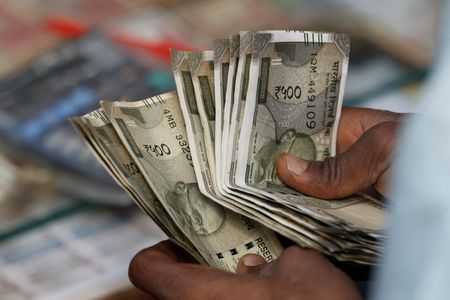By Jaspreet Kalra
MUMBAI (Reuters) – The Indian rupee gave up initial gains to settle marginally weaker on Wednesday, as hedging interest from importers and the maturity of positions in the non-deliverable forwards market boosted demand for the dollar.
The rupee closed at 86.8925 against the U.S. dollar, down from its close at 86.8275 in the previous session.
The currency rose to a near-two-week high of 86.47 in early trading but shed its gains amidst heightened demand to buy dollars at the daily reference rate published by the central bank, traders said.
Likely outflows from Indian stocks also hurt the rupee while mild dollar sales from state-run banks kept a lid on its losses, a foreign exchange salesperson at a bank said.
Despite several headwinds including portfolio outflows and global trade war concerns, the bearish bias on the rupee has eased following the central bank’s firm interventions on Monday and Tuesday.
The currency has weakened over 1% so far in 2025 and is among the worst performing Asian currencies.
The dollar index was a tad higher at 108 while Asian currencies were largely rangebound ahead of the release of closely watched U.S. consumer inflation data later in the day.
The data is expected to influence expectations of when the Federal Reserve may deliver its next rate cut. Fed Chair Jerome Powell reiterated on Tuesday that the central bank doesn’t need to rush to lower policy rates.
“The challenge for traders is that, despite some fatigue in the Trump trades, there’s no way to predict if tomorrow will be the day Washington significantly expands tariffs,” ING Bank said in a note.
On Monday, U.S. President Trump unveiled a 25% tariff on all aluminium and steel imports and has said he intends to announce reciprocal tariffs this week, applying them to all countries and matching the tariff rates levied by each of them.
(Reporting by Jaspreet Kalra; Editing by Mrigank Dhaniwala)











